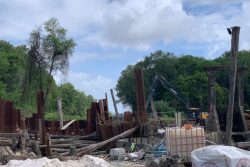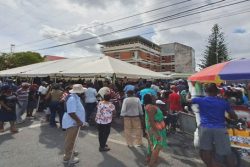Dear Editor,
Not a single Guyanese for, or against any democratically elected government of the day, nor even the ‘politically undecided’ should consider the threat by Vene-zuela to use force to seize a large chuck of Guyanese territory to be unreal or unimagined… It is real! There is no tomfoolery about the promulgation by Venezuela of its ‘Organic Law for the Defence of Guayana Esequiba.’ There are certain lessons to be learnt from history though we should not take comfort from them. Examples abound where authoritarian regimes resorted to the use of force to occupy territory other than their own. Three examples will suffice to demonstrate where this was done in flagrant violation of international law.
Turkey’s military invasion and eventual occupation of a significant portion of Cyprus’s territory known as Northern Cyprus was initiated on 20 July 1974. The event took place against the backdrop of inter-communal violence between Greek and Turkish Cypriots, and in response to a Greek inspired military coup in Cyprus. To enforce its occupation policy, Turkey mobilized 40,000 troops plus 20,000K Turkish-Cypriots bringing the total of occupying soldiers to 60,000. At the onset, Turkish forces captured 3% of the Mediterranean island. Later, the occupying force enlarged its original beachhead resulting in the capture of 36 percent of Cyprus’ territory.
Turkey’s occupation policy resulted in the displacement of 200,000 Greek-Cypriots and 50,000 Turkish-Cypriots. The Turkish invasion ended in the partition of Cyprus along UN-monitored ‘Green Line’, which still divides Cyprus, and the formation of a de facto autono-mous Turkish Cypriot Administration in the north. In 1983, the Turkish Republic of Northern Cyprus (TRNC) declared independence, although Turkey is the only country that recognises it. The international community considers the TRNC’s territory as Turkish-occupied territory of the Republic of Cyprus. The occupation is viewed as illegal under international law, amounting to illegal occupation of European Union territory since Cyprus became a member in May 2004.
The next example was in 1982, when Argentina decided to take over the Falkland Islands by military means resulting in an undeclared war over the sovereignty of the Islands. Known as ‘Islas Malvinas’ in Argentina, South Georgia and the South Sandwich Islands to the British, the conflict lasted 74 days and costed over 900 lives. The islands are considered to be British Overseas Territories located in the South Atlantic, 8,000 miles from Britain. Sovereignty over the islands has been contested by Argentina since 1833. Most Falkland Islanders are of British descent and oppose Argentina’s claim. Argentina believed the British had taken control of the islands illegally in 1833.
But with the seizure of power in December 1981 by a military junta, led by General Leopoldo Galtieri, Argentina determined that the islands should be retaken by force. Thus on 2 April 1982, Argentine forces mounted amphibious landings, known as ‘Operation Rosario’, on the Falkland Islands. In response, British Prime Minister Margaret Thatcher authorised a military operation, codenamed ‘Operation Corporate’, to retake the islands. It was the first time since the Second World War in which all branches of the British armed forces were deployed simultaneously. After fierce fighting ended between British and Argentine troops, Argentinian forces surrendered on 14 June. Over 11,000 Argentinian troops were disarmed and repatriated to Argentina. The British retook control of the South Sandwich Islands. 907 lives were lost during the conflict: 649 Argentinian, 255 British and three Falkland Islanders.
The Falklands War between the United Kingdom and Argentina did not result in NATO involvement because Article 6 of the North Atlantic Treaty specifies that collective self-defense is applicable only to attacks on member state territories north of the Tropic of Cancer. While the islands continue to be British Overseas Territories under the protection of its South Atlantic Islands Forces, the dispute with Argentina remains unresolved. The third example has to do with Israel’s occupation of Palestinian lands, and the Golan Heights belonging to Syria. The Golan Heights are a rocky plateau in the Levant region of Western Asia that was captured by Israel from Syria in the 1967 Six-Day War.
The international community, with the exception of Israel and the United States, generally regards the Golan Heights to be Syrian territory held by Israel under military occupation. The Golan Heights was under military administration until the Israeli parliament passed ‘The Golan Heights Law’ in 1981, which applied Israeli law to the territory; a move that has been described as an annexation. In response, the United Nations Security Council unanimously passed UNSC Resolution 497 which condemned the Israeli actions to change the status of the territory declaring them “null and void and without international legal effect”, and that the Golan Heights must remain an occupied territory.
In 2019, the United States became the only state to recognize the Golan Heights as Israeli sovereign territory, while the rest of the international community continue to consider the territory belonging Syria held under Israeli military occupation.
Sincerely,
Clement J. Rohee




